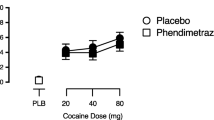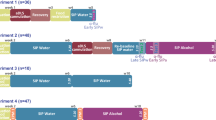Abstract
Individuals who were using therapeutic doses (approximately 15 mg diazepam or its equivalent daily) of a benzodiazepine persistently and wished to attempt to stop were recruited into a study offering a medically supported outpatient behavioral treatment with a goal of abstinence. All subjects received the same behavioral treatment that emphasized the development of strategies for coping with abstinence and alternatives to benzodiazepines as a coping mechanism. The goal of abstinence was to be achieved within approximately 8 weeks by means of gradual tapering of the daily dose. Some subjects (Group D, n=23) were randomly assigned to a condition in which their dose was to be tapered on a regime of active diazepam. Others (Group P, n=19) were switched to placebo at the first treatment session and “tapered” from this pharmacologically inert substitute for diazepam. Supplies of tablets of each preparation were provided by the experimenters, and subjects were specifically requested to use only those tablets. The principal dependent variable was “supplementation”, or use of a benzodiazepine other than that specifically authorized by the therapist. Supplementation was detected by measures of plasma benzodiazepine levels as compared to levels predicted if there had been strict compliance with the therapeutic regime. These comparsions were made by two expert judges who were blind to the subjects' experimental assignment. Self-report of supplementation was also obtained. Plasma level determinations indicated a significantly greater frequency of supplementation (84% versus 33% of subjects) for subjects in Group P. This was corroborated by self-report. These data support the assertion that dependence on low doses of benzodiazepines has a pharmacologic basis, and that there is a causal relationship between deprivation of a benzodiazepine and its self-administration in dependent persons.
Similar content being viewed by others
References
Balter MB, Manheimer DI, Mellinger, GD, Uhlenhuth EH (1984) A cross-national comparison of anti-anxiety/sedative drug use. Curr Med Res Opin 8 (Suppl 4):5–20
Bigelow GE, Griffiths RR, Liebson I (1976) Effects of response requirement upon human sedative self-administration and drug-seeking behavior. Pharmacol Biochem Behav 5:681–685
Bowden CL, Fisher JG (1980) Safety and efficacy of long-term diazepam therapy. South Med J 73:1581–1584
Busto U, Sellers EM, Cappell H, Naranjo CA, Sanchez-Craig M (1986) Patterns of benzodiazepine abuse and dependence. Br J Addict 81:87–94
Busto U, Sellers EM, Naranjo CA, Cappell H, Sanchez-Craig M, Sykora K (1986) Pharmacologic basis of the withdrawal reaction after persistent and long-term therapeutic benzodiazepine use. N Eng J Med (in press)
Caplan RD, Abbey A, Abramis DJ, Andrews FM, Conway TL, French JRP Jr, (1984) Tranquilizer use and well-being. Survey Research Center, Institute for Social Research, University of Michigan
Cappell H, LeBlanc AE (1981) The relationship of tolerance and physical dependence to alcohol abuse and alcohol problems. In: Kissin B, Begleiter H (eds) The biology of alcoholism, vol VII. Plenum, New York London, pp 359–414
Catalan J, Gath DH (1985) Benzodiazepines in general practice: time for a decision. Br Med J 290:1374–1376
Cooperstock R, Hill J (1982) The effects of tranquillization: Benzodiazepine use in Canada. Health and Welfare Canada, Ottawa
Cooperstock R, Lennard HL (1979) Some social meanings of tranquilizer use. Social Health Illness 1:331–347
deWit H, Johanson CE, Uhlenhuth EH, McCracken S (1983) The effects of two nonpharmacological variables on drug preference in humans. In: Harris, LS (ed) Problems of drug dependence, 1982. National Institute of Drug Abuse Research Monograph No 43, DHHS Publication No (ADM) 83–1264. US Govt Printing Office, Washington DC, pp 251–257
deWit H, Johanson CE, Uhlenhuth EH (1984) Reinforcing properties of lorazepam in normal volunteers. Drug Alcohol Depend 13:31–41
Griffiths RR, Ator NA (1981) Benzodiazepine self-administration in animals and humans: A comprehensive literature review. In: Szara SI, Ludford JP (eds) Benzodiazepines: A review of research results, 1980. National Institute on Drug Abuse Research Monograph No 33, DHHS Publication No (ADM) 81–1052. US Govt Printing Office, Washington DC, pp 22–36
Griffiths RR, Bigelow GE, Liebson I (1976) Human sedative self-administration: Effects of interingestion interval and dose. J Pharmacol Exp Ther 197:488–494
Griffiths RR, Bigelow GE, Liebson I (1979) Human drug self-administration: Double-blind comparison of pentobarbital, diazepam, chlorpromazine and placebo. J Pharmacol Exp Ther 210:301–310
Griffiths RR, Bigelow GE, Liebson I, Kaliszak JE (1980) Drug preference in humans: Double-blind choice of pentobarbital, diazepam and placebo. J Pharmacol Exp Ther 215:649–661
Griffiths RR, Bigelow GE, Liebson I (1983) Differential effects of diazepam and pentobarbital on mood and behavior. Arch Gen Psychiatry 40:865–873
Griffiths RR, McLeod DR, Bigelow GE, Liebson I, Roache JD, Nowowieski P (1984) Comparison of diazepam and oxazepam: Preference, liking, and extent of abuse. J Pharmacol Exp Ther 229:501–508
Griffiths RR, Lamb RJ, Ator NA, Roache JD, Brady JV (1985) Relative abuse liability of triazolam: Experimental assessment in animals and humans. Neurosci Biobehav Rev 9:133–151
Hillestad L, Hansen T, Melsom H (1974) Diazepam metabolism in normal man II. Serum concentration and clinical effect after oral administration and cumulation. Clin Pharmacol Ther 16:485–489
Hollister L (1981) Dependence on benzodiazepines. In: Szara SI, Ludford JP (eds) Benzodiazepines: A review of research results, 1980. National Institute on Drug Abuse Research Monograph No 33, DHHS Publication No (ADM) 81–1052. US Govt Printing Office, Washington DC, pp 22–36
Jaffe JH, Ciraulo DA, Nies A, Dixon RB, Monroe LL (1983) Abuse potential of halazepam and of diazepam in patients recently treated for acute alcohol withdrawal. Clin Pharmacol Ther 34:623–630
Johanson CE, Uhlenhuth EH (1980) Drug preference and mood in humans: Diazepam. Psychopharmacology 71:269–273
Lucki I, Rickels K, Geller AM (1985) Psychomotor performance following the long-term use of benzodiazepines. Psychopharm Bull 21:93–96
Margules DL, Stein L (1968) Increase of “antianxiety” activity and tolerance of behavioral depression during chronic administration of oxazepam. Psychopharmacologia 13:74–80
Rickels K, Case WG, Downing RW, Winokur A (1983) Long-term diazepam therapy and clinical outcome. JAMA 250:767–771
Roache JD, Griffiths RR (1985) Comparison of triazolam and pentobarbital: Performance impairment, subjective effects and abuse liability. J Pharmacol Exp Ther 234:120–133
Sanchez-Craig M (1984) A therapist's manual for secondary prevention of alcohol problems. Addiction Research Foundation, Toronto
Sepinwall J, Grodsky FS, Cook L (1978) Conflict behavior in the squirrel monkey: Effects of chlordiazepoxide, diazepam and N-desmethyldiazepam. J Pharmacol Exp Ther 204:88–102
Spielberger CD, Gorsuch RL, Lushene RE (1970) STAI manual. Consulting Psychologists Press, Palo Alto
Warner RS (1965) Management of the office patient with anxiety and depression. Psychosomatics 5:347–351
Author information
Authors and Affiliations
Additional information
The views expressed in this paper are those of the authors and do not necessarily represent those of the Addiction Research Foundation
Rights and permissions
About this article
Cite this article
Cappell, H., Busto, U., Kay, G. et al. Drug deprivation and reinforcement by diazepam in a dependent population. Psychopharmacology 91, 154–160 (1987). https://doi.org/10.1007/BF00217055
Received:
Revised:
Issue Date:
DOI: https://doi.org/10.1007/BF00217055




